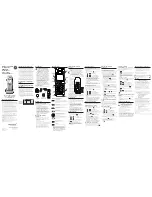
PG7000™ OPERATION AND MAINTENANCE MANUAL
© 1998-2008 DH Instruments, a Fluke Company
Page 166
4.4
STATUS SYSTEM
The status system includes the status reporting system which reports general PG7000 events. The user
can select which PG7000 events will cause a status change event. These events are then reported to
the status system (bit7 and bit3 of the status byte register), which also must be configured for the STATus
subsystem to generate the service requests described in Section 4.4.1, Status Reporting System.
There are two 16 bit event registers that make up the top layer of the status subsystem. The OPERation
status register handles conditions that are normal for PG7000. The QUEStionable status register
handles events that could cause measurements to be made under questionable conditions.
Other registers layered below these two registers provide the structure necessary to handle the two RPT
channels and to enable the events and event transitions. Bit15 of all of these registers is not used
because Bit15 represents a sign bit on some computer systems.
4.4.1
STATUS REPORTING SYSTEM
The PG7000 status reporting system is used to track and report system status and errors.
The status subsystem is layered under and reports to the status reporting system. It follows
the model of the IEEE Std 488.2 and works for the COM1 and the IEEE-488 port with
slight differences. PG7000 can be programmed to respond to various status conditions by
asserting the SRQ of the IEEE-488 interface. The COM1 port cannot be supported in this
manner, so polling must be used.
4.4.1.1
STATUS BYTE REGISTER
PG7000 contains an 8 bit status byte register that reflects the general status of PG7000.
Table 26
.
Status Byte Register
OPER
(128)
RQS/MSS
(64)
ESB
(32)
MAV
(16)
N/A
(8)
ERROR
(4)
N/A
(2)
RSR
(1)
This register is affected by the PG7000 reply output queue, the error queue, the
Standard Event Status register, the Ready Event Status register, and the
STATus subsystem.
(“
∗
STB?” or “
∗
SRE
n”)
OPERation
Bit7 (128)
OPERation summary bit
RQS/MSS
Bit6 (64)
Standard Event Status Register
(“
∗
ESR?” or “
∗
ESE
n”)
ESB
Bit5 (32)
PON
Bit7
URQ
Bit6
CMD
Bit5
EXE
Bit4
DDE
Bit3
QYE
Bit2
RQC
Bit1
OPC
Bit0
MAV
Bit4 (16)
OUTPUT
QUEUE
N/A
Bit3 (8)
ERROR
Bit2 (4)
ERROR
QUEUE
N/A
Bit1 (2)
N/A
Bit0 (1)
Figure 12.
Status Byte Register
















































